|
1.
CENTRAL/ WEST AFRICA
Prices slide as European demand lags
Certain log prices fell as markets experienced some
significant changes in demand. Buyers from China have
become much more selective and concentrated on
purchases of separate grades of okoume in place of
previous emphasis on mixed, lower grades. Redwoods
were also moving sluggishly, as a result of changed
buying patterns in the past few weeks. Some producers
were reducing output and waiting to see how the market
developed. Log buying for Europe also turned quieter with
only France being relatively active.
Sawn lumber markets were reporting much slower
business, with some countries that had high stocks of
previously favored species showing quite large price falls
for the second time in recent weeks. Douka/makore was
down again for GMS and scantlings. Moabi was also
retreating, ending its long run of price rises. Sapele FAS
declined by EUR60 on lower demand from Spain and the
UK. UK importers were particularly hit by poor demand
from the building and carpentry sectors and have
reportedly been selling well below replacement cost at the
present time.
West African exporters are preparing for a more volatile
market situation over the rest of the second quarter and
reducing output where necessary to match the fall in demand.
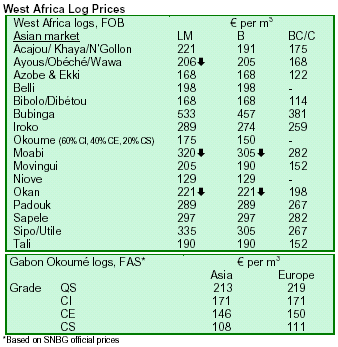
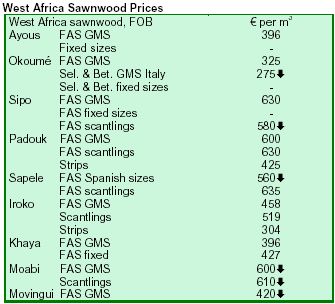
2. GHANA
Non-traditional export earnings breach USD1 billion mark
Ghana¡¯s Non-Traditional Exports (NTE) revenue for 2007
crossed the targeted USD1 billion mark for the first time,
reaching an all time high of USD1.165 billion. This
marked a 30.5% increase over Ghana¡¯s NTE income for
2006, when income was USD892 million. NTE
represented 27.7% of the country¡¯s total exports of
USD4.2 billion. The income growth was achieved on the
back of earnings from three main sub-sectors: agriculture;
processed and semi-processed products; and handicrafts.
Speaking at a press briefing on the 2007 export
performance report, the Executive Secretary of the Ghana
Export Promotion Council (GEPC), Mr. Collins Boateng,
attributed the high growth to enhanced market access
programmes for exporting companies benefiting from the
support of the Export Development Investment Fund. He
also noted that product diversification, the aggressiveness
of Ghanaian exporters and enhanced data capture through
the GCNet system contributed to the growth. Boateng
believed the new income levels were proof that the
Ghana¡¯s strategy was working.
The European Union (EU) and ECOWAS remained the
major destinations of NTE, accounting for 46.5% and
31.3%, respectively, of the exports. The leading markets
included the United Kingdom, France, Nigeria, Burkina
Faso, Togo and the United States. Nigeria has become a
prominent NTE market in the ECOWAS sub-region.
While acknowledging the impressive growth in the NTE
sector, Mr. Boateng said there was a need for increased
funding if the sector was to meet its projection of four
billion dollars in export revenue by 2010. The GEPC has
projected target of USD1.5 billion by December 2008,
Boateng added. Currently, there are 383 different nontraditional
export products categorized into agricultural,
processed/semi-processed and handicrafts. The GEPC had
a base of over 3,000 registered private sector exporting
companies organized into 15 product associations.
Preparatory phase begins for President¡¯s Special Initiative
The Ministry of Lands, Forestry and Mines and the
Forestry Commission (FC) intended to disburse part of its
2008 budget for plantation development for civil works in
degraded forests. The development of plantations falls
under the President¡¯s Special Initiative (PSI) on
afforestation and reforestation in degraded forest reserves.
The Ministry has begun preparatory work to contract the
services of consulting firms, companies and agencies to
provide services which include surveying and digital
mapping of established plantations.
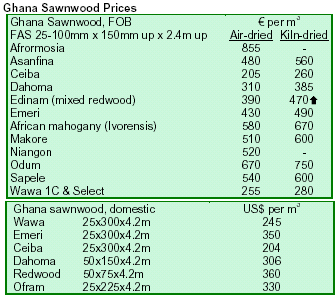
3.
MALAYSIA
Uncertain demand clouds export expectations for 2008
The Star Online reported on Malaysia¡¯s export prospects
for 2008, drawing from the Malaysian Timber Industry
Board¡¯s (MTIB) comments that demand from the US,
Europe and Japan would largely determine export levels in
2008. An MTIB spokesperson, Kamaruzaman Othman,
noted that timber exports in 2007 were adversely affected
by the slowdown of the U.S. economy. He reported on
Malaysia¡¯s total timber exports statistics in 2007 to the
following countries/regions: Japan (RM4.8 billion); the
EU (RM3.63 billion); the US (RM2.91 billion); ASEAN
countries (RM2.19 billion); West Asia (RM1.78 billion);
South Korea (RM1.14 billion); China (RM1.12 billion);
Taiwan SAR (RM1.04 billion); and other countries
(RM4.06 billion).
Prices of Malaysian wood products continue to rise in part
due to surging global commodity prices, higher fuel costs
and bad weather.
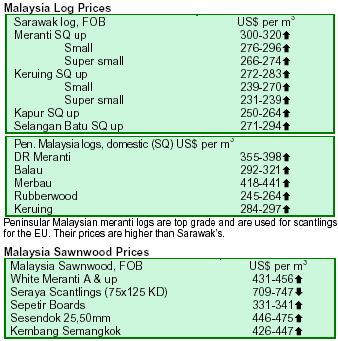

4.
INDONESIA
Jump in prices as port strikes dissipate
Indonesian timber prices surged as strikes by port workers
ended. Plywood manufacturers were the main beneficiary
of the latest round of price increases. This has also filtered
down to timber merchants trading plywood logs. Bad
weather was also a major contributory factor in the price
changes and the effects of La Nina were expected to
persist for an additional three months.
Antara Online said that the International Monetary Fund
IMF) indicated strong consumer prices would help stave
off the effects of the global economic slowdown.
However, local demand for timber products and other
building materials, including cement, has been tempered
by rising food prices. Indonesian officials have recently
said the UN should adopt measures against rising prices
for food commodities to prevent a full-scale crisis.
Indonesia¡¯s UN Ambassador, Marty Natalegawa, said
there were no short or long-term plans to address world
food prices.
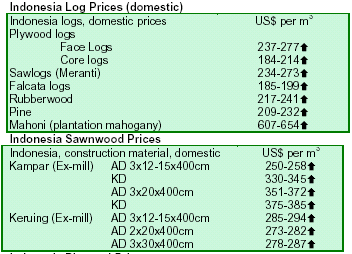
5.
MYANMAR
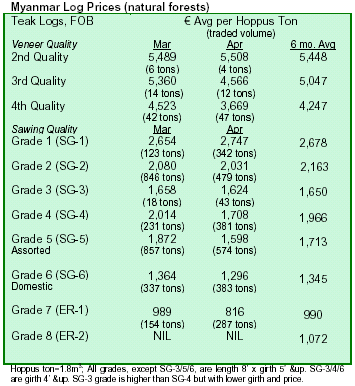

6.
BRAZIL
IBAMA uncovers more cases of illegal harvesting
The Brazilian Institute of Environment and Renewable
Resource (IBAMA) uncovered 730 hectares of natural
forest that were being illegally harvested in Bannach
municipality in the southeast region of Par¡¡ì¢. According to
Folha Online, Bannach was not included in the list of
municipalities that experienced the most deforestation in
2007. The list was the basis by which IBAMA conducted
their raids on suspected illegally logged areas in the
Amazon.
According to the IBAMA Maraba Regional Office (in
Para), deforestation in Bannach likely started in January
2008. Due to the rainy season, satellite monitoring could
not be used to assess the extent of deforestation caused by
illegal logging. Access to the areas was difficult in the
rainy season, and inspectors could only reach the area with
a local guide.
The property-owner of the 730 hectares in Bannach had 20
days to present a preliminary defense. In the meantime, the
area was embargoed and could not be used for any
activities. In addition to the fine imposed by IBAMA, an
infraction against the owner will be sent to the Federal
Prosecution Office, which may then choose to proceed
with a criminal investigation. According to IBAMA, it
was expected that the deforested area was to be used for
cattle ranching.
IBAMA imposes fines worth BRL3.3 million in one
month
According to So Noticias, IBAMA fined companies and
property owners BRL3.3 million in the first month of its
¡®Arco de Fogo¡¯ operations to control illegal logging and
associated activities in the Brazilian Amazon. The ongoing
operations (see TTM 13:4-7) have been conducted
primarily in the regions of Sinop and Alta Floresta. In the
first month of its operation, IBAMA inspected 20 charcoal
and timber production companies, resulting in over 46
companies being fined. According to IBAMA, 4,500 m3 of
logs, sawnwood and veneer were deemed to be from
illegal sources and seized. In addition, 10 vehicles and
three chainsaws were confiscated. Some of the timber
companies accused by IBAMA of conducting illegal
activities have since obtained legal permission to conduct
legal timber related activities elsewhere. The IBAMA
inspection operations are expected to continue in the near
future. It is not known when IBAMA expects to conclude
the operations.
Brazil exports slide 5% in March
In March 2008, the value of exports of general wood
products (except pulp and paper) fell 5% compared to the
same period in 2007, from USD339.6 million to
USD322.7 million. The charts below show the volume and
value of exports over the March 2007¡ªMarch 2008
period:
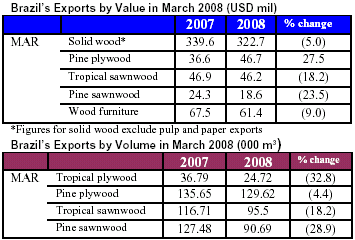
Alta Floresta and Sinop clusters sustain timber
exports in 2008
According to S¡¡ì® Not¡¡ìªcias, Alta Floresta and Sinop
continued to deliver competitive levels of exports in 2008
and remain the major wood clusters in Northern Mato
Grosso. Alta Floresta is not among the main exporting
regions of the state but has an important role in the timber
trade. Timber dominated exports from Alta Floresta in the
first quarter of 2008, reaching USD4.1 million in value,
according to the Secretary of Foreign Trade. In 2007, the
total trade of the municipality reached USD4.2 million in
the first quarter.
The most popular solid wood products from Alta Floresta
in the international market were wood mouldings,
sawnwood and manufactured products such as doors,
frames and doorsteps. The value exported in January was
USD1.6 million, 31% higher than the same period last
year. The US was the main destination of wood product
exports from Alta Floresta, accounting for 46% of exports
by value, equivalent to USD1.9 million, followed by Spain
with 24% and Israel 14%.
On the other hand, exports from Sinop were USD4.9
million in March 2008, down 27% compared to the same
period in 2007 when exports reached USD6.7 million.
Overall, Sinop¡¯s first quarter exports in 2008 dropped 20%
from USD 14.6 million in 2007 to USD11.8 million in
2008.
Despite the negative scenario in Sinop, the wood products
trade continues to be important to the economy of the
region. In the first quarter of 2008, sawn timber was nearly
50% of the value of exports, equivalent to BRL 6 million.
Veneer exports were 233% higher than the same period in
2007; plywood and wood mouldings also were among the
major traded wood products. The main importing
countries of Sinop¡¯s products were Belgium followed by
Spain, Italy and Thailand.
Strong gains in regional exports by Brazil
Brazil exported USD45.2 million of furniture to the U.S.
in the first quarter of 2008, down 27% in value compared
to the same period in 2007. Nevertheless, the U.S.
continues to be the major destination market for Brazilian
furniture, taking 21% of total exports. On the other hand,
Brazilian exports of furniture to Argentina continued on a
growing trend, with exports worth USD21.3 million in the
period, a 38% increase. The Netherlands imported the
equivalent of USD8 million, representing a 34% rise.
Rio Grande do Sul exported USD63.7 million of furniture
in the first quarter of 2008. Despite the small increase of
2%, it was below the average of total Brazilian furniture
exports. Rio Grande do Sul furniture sector exports to the
US were USD3.9 million, a 47% slump. The United
Kingdom, the main importer of the state¡¯s furniture
exports (17% of total state exports), purchased USD8.9
million from January to March 2008, 16% less than the
same period last year. Furniture exports to Venezuela have
increased drastically by 493% during the period and
amounted to USD3.9 million.
The Southern state of Santa Catarina's share of total
Brazilian furniture sales was 34%, followed by Rio
Grande do Sul with 29% and Sao Paulo with 15%.
However, Santa Catarina's share has been gradually
falling.
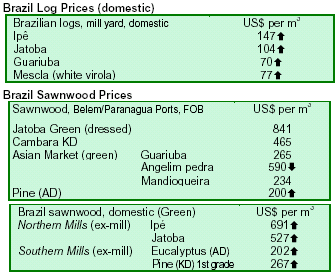
7. PERU
Domestic demand drives Peru's production of forest
products
Domestic consumption has increased to such as level that
veneer and plywood mills are working at 100% installed
capacity. Mr. Ricardo Duenas, head of the Forest Products
Sector of PROMPERU, said high production levels are
expected to continue over the next five or six months. He
noted that the heightened outputs are due mainly to the
high growth of domestic demand and waning export
capacity by companies. Tree species such as capinur?
catahua and kapok (Ceiba sp.) are primarily used as the
raw material for Peru's plywood.
EU and CAN make progress in trade talks
Negotiations between the Andean Nations Community
(CAN) and the European Union (EU) continued despite
the recent crisis between Ecuador and Colombia, reported
the Chief of the EC delegation, Antonio Cardoso Mota.
Cardoso said that the agreement between CAN and the EU
was based on three pillars: political dialogue, technical
cooperation for development and commercial trading. He
admitted that the Colombian raids in Ecuador could have
been detrimental to the negotiations, but said constructive
dialogue between CAN and the EU allowed the parties to
move forward.
Ecotourism project poses benefits and threats to
Amazonian rainforest
The Economist recently reported on the success of a
Peruvian ecotourism project. The project allows
community owners living in the ecotourism area to share
in decision-making while receiving 60% of the profits
from the project. The article said the community members
were being trained to take over the operation in 2016 and
early outputs had helped raise literacy, healthcare and
nutrition standards in the community. Although most of
the rainforest continues to remain unspoiled, the article
noted public concerns over the impact of roads, which
were likely to spur future development in the region.
Conservationists and ecotourism operators were aware of
the possible threats of the roads, with one conservationist
hoping to establish an ecotourism corridor along the roads
in the rainforest.
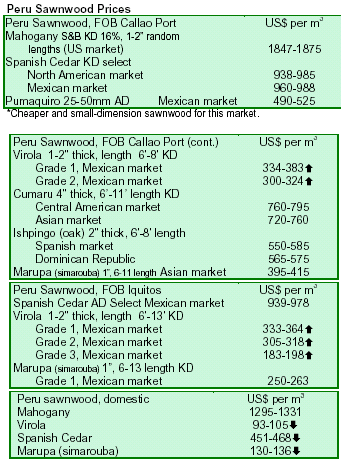
8. BOLIVIA
Business roundtable nets 48% gain in contracts
The Fourth Business Wood Roundtable organized by the
Forest Chamber of Bolivia (CFB) recorded business deals
of USD27.6 million dollars, a 48% jump over the amount
of last year¡¯s total contracts. The amount resulted from
over 1,300 business negotiations between 201 companies
registered at the conference. Over 60 companies from 18
countries participated in the event.
Bolivia hosts investment workshop on tropical forests
From 26-27 March 2008, the CFB, in conjunction with
USAID and ITTO, convened a national investment
workshop on tropical forests. The event was held as part of
Expoforest 2008 and attracted more than 150 participants
from the private sector, investors, banks, consultants,
universities and executives from the forest sector. The
workshop discussed Bolivia¡¯s plans and policies for
tropical forest investment in Santa Cruz and other regions
of Bolivia and South America¡¯s tropical forest products
trade in international markets.
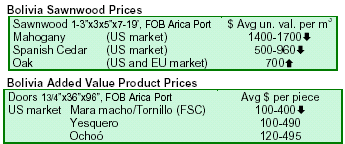
1
9.
Mexico
Germplasm banks give hope to threatened forest
species
In July 2007, the President of Mexico, Felipe Calderon
Hinojosa, announced the creation of ambitious projects to
preserve Mexico¡¯s biodiversity, the National System of
Forest Resources and the National Center for Forest
Genetic Resources. Germplasm from forest seeds and
spores are collected and conserved as high-value products.
The materials have already been used to conserve certain
vegetative species or improve their resistance, productivity
and tolerance to certain climates. At present, CONAFOR,
the national forest agency, has 17 germplasm banks, which
can be used for immediate seed production.
UK government provides finance for mangrove
swamps
The UK government will contribute 3,322,000 Mexican
pesos this year in mangrove swamps in Nayarit to
strengthen the capacity of community lands (¡®ejido¡¯). The
project, called the ¡®Regional Action Plan for the
Restoration of Mangrove Swamps in Nayarit¡¯, will be used
for environmental education and investigation on
economic alternatives for environmental use. It is
anticipated that the project will benefit more than 20
community lands and communities in the area. Activities
associated with the project began in February 2008 and are
expected to be complete in two and a half years.
10. GUYANA
GFC undertakes greater scrutiny of forest concessions
The Guyana Forestry Commission (GFC) has increased its
monitoring of forest concessions to ensure that
concessionaires practice sustainable forestry in accordance
with the rules set out by the Commission. Over 30
additional permanent field staff have been hired to
facilitate these activities, and the GFC is in the process of
enhancing the physical resources available to strategic
field offices. The new measures follow findings in 2007
that show companies harvested logs outside of their
approved blocks. One company in 2008 has repeatedly
breached harvesting rules. The GFC has instituted the
appropriate penalties against the company and will
continue to examine the operations of other concessions in
an effort to maintain the highest level of sustainable forest
management practices and legality throughout the country.
Guyana¡¯s dressed lumber show highest price gains
Guyana¡¯s exports of piles have begun to increase,
following a drop earlier in the year, as export earnings for
the first fortnight of April were almost equal to the
monthly average for 2007. Earnings have so far exceeded
the monthly average for 2008 by 12 percent. Meanwhile,
prices for dressed lumber have reached their highest levels
in recent times, with purpleheart prices exceeding
USD1,000 per m3 over the first two weeks of April 2008.
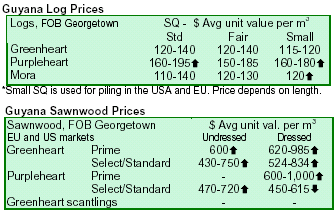
. GUYANA
|